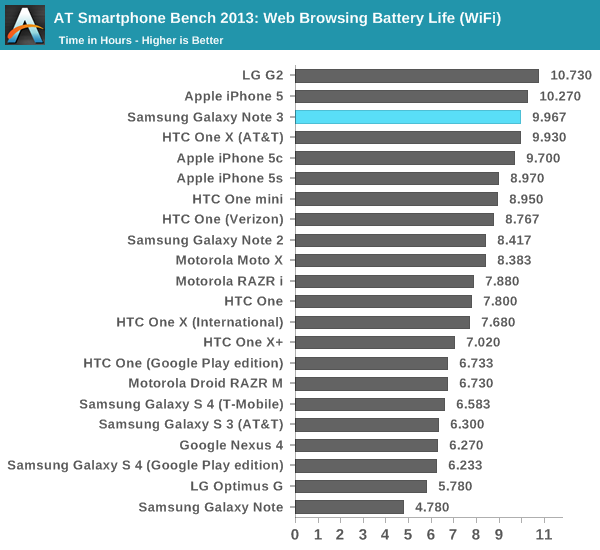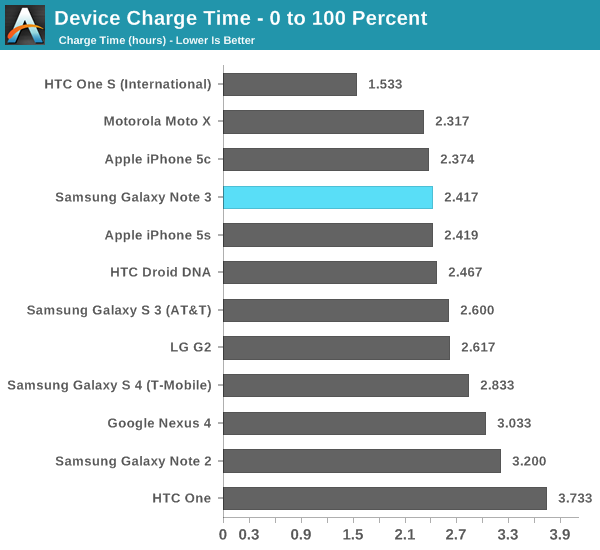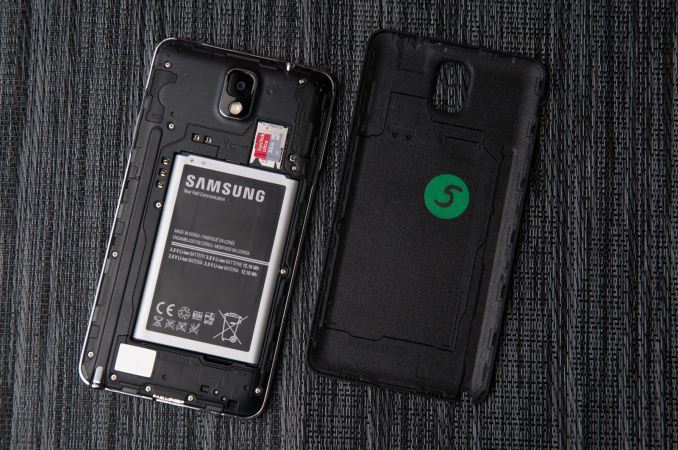Samsung Galaxy Note 3 Review
by Brian Klug on October 1, 2013 9:00 AM EST- Posted in
- Smartphones
- Samsung
- Mobile
- Android 4.3
- galaxy note 3
Battery Life
Battery life remains probably the single largest differentiator for devices lately, and of huge concern to enthusiasts and normal shoppers alike. We’ve already caught a glimpse of how well 8974 fares from a power perspective inside the LG G2, a device that posted some seriously impressive battery numbers. The Note 3 we’re looking at is also 8974 based since it’s a T-Mobile model, and thus we expect the same kind of battery life.
With this generation of Note, battery gets even larger. The Note started with a then quite large 9.25 watt hour battery, then Note 2 moved to 11.78 watt hours, and Note 3 now moves to a very large 12.16 watt hour battery with of course the newest 3.8V chemistry and all that comes along with it. Display size goes up, but those power gains are offset in other places.
After we talked about the panel self refresh features in the G2 a few people reached out and let me know that this feature has been shipping for a while in some phones, and it’s easy to check for. If we look under the display subsystem we can see that the same MIPI_CMD_PANEL type 9 is used, which refers to this type of interface.
Qualcomm HWC state: MDPVersion=500 DisplayPanel=9
define MIPI_CMD_PANEL ‘9’
Our battery life tests are unchanged and consist of a set of popular webpages that are loaded on a schedule with the display set to exactly 200 nits and repeated until the battery runs out and the device dies on both WiFi and cellular data connections. In this case that means T-Mobile LTE which is 10 MHz FDD in my market, I haven’t had a chance to run the Note 3 on HSPA+ yet, or complete the call test (which is starting to get ridiculous, and probably breaks 24 hours in the case of the Note 3).

On LTE the Note 3 does very well, coming just shy of the pack of iPhones, at just over 8 hours. Interestingly enough it’s just north of the G2s as well, which do have a smaller battery but also smaller display. The Note 3 also is the first device to ship with Qualcomm’s QFE1100 envelope tracker solution from the RF360 front end portfolio, which lowers power consumption by up to 20 percent and heat dissipation by up to 30 percent by allowing the power amplifiers to follow the desired output waveform. There’s more on that later in the cellular section.

On WiFi the Note 3 does better by 22 percent, but not the kind of huge jump I’m used to seeing between cellular and WiFi testing. This tells me the Note 3 battery life is really gated by the display, which is almost always the largest consumer of power in a device. That said the Note 3 does very well all things considered, especially in comparison to the APQ8064 (Fusion 3) phones which came before it, like SGS4. New silicon and new process inside MSM8974 definitely helps move battery life forward here with the race to sleep game.
Charging is an interesting story on the Note 3, but primarily because of what doesn’t change. The Note 3 continues to use Samsung’s tablet charging specification and charger, which has 2 amps of maximum output. The Note 3 draws 2 amps over a considerable amount of the charging curve, like other Samsung devices (in the linear part of the charge curve). USB 3.0 doesn’t change things up here quite yet with the new supported charge voltages that are coming eventually with the power delivery specification.

The Note 3 does charge faster overall compared to the SGS4 however thanks in part to the new PMIC (PM8941) which is part of the overall 8974 platform story.











302 Comments
View All Comments
Spunjji - Tuesday, October 8, 2013 - link
Says you.kapg - Wednesday, October 2, 2013 - link
I really respect Anandtech and consider it to be the top benchmark for all tech related stuff.That said I am not sure of a couple of the following things and would really appreciate if someone can please throw some light on these to help me understand these better:
- Browsing benchmarks like Sunspider Javascript Benchmark 1.0, Google Octane Benchmark v1, Mozilla Kraken Benchmark – 1.1 & Browsermark 2.0...are these dependenton/affected by the screen resolution, if so then should they not be run on the same resolution for different devices to provide an ideal representation of the CPU??
- Why is it that all benchmarks that Anantech runs are not run with the same set of devices, some benchmarks are with a certain set and with other benchmarks devices are added. I can understand that not all devices support the same set of benchmark tools but as that is the case should we not test only on those benchmarks that are common to all devices (or on which all devices can be made to run/simulated).....this is just coz it is pretty confusing for a non-expert as me to compare two devices (say Apple iPhone 5s vs Nokia 925 vs Samsung S4)
Am sorry if these querries are noobish as I do not understand the in-depth details of these benchmarks and hope someone can clarify.
peace,
~kg
thunng8 - Wednesday, October 2, 2013 - link
JavaScript and browser benchmarks are not dependent on screen resolutionSamunosuke - Wednesday, October 2, 2013 - link
In the pc world, if it was discovered that Sager's GT780m consistently benched higher than equivalent Alienware/MSI/Asus etc 780m but yet performed the same in games, what would be the reaction? I was surprised when the galaxy s4's benchmark boost was glossed over just because some of samsung's apps were included. That doesn't make it acceptable. The cpu/gpu is a known factor and should be the same for all apps regardless of origin or use. Boosting benchmarks is wrong, plain and simple. All manufacturers who do it should be called out. There are several ways to curb this:1. Do what arstechnica did and circumvent the benchmark boost by renaming the benchmark software (you can keep that and use on all devices from here on out and updating when necessary).
2. Run battery life tests in the boosted state (by renaming the browser/media player/whatever you use to run the battery life tests to a boosted app).
Its not fair if other devices either have lower battery life due to increased performance or higher battery life due to reduced performance and yet others find a way to inflate their scores and get the best of both worlds.
kapg - Wednesday, October 2, 2013 - link
"2. Run battery life tests in the boosted state (by renaming the browser/media player/whatever you use to run the battery life tests to a boosted app)."I do not agree with running battery life test in the boosted state as that is not the regular mode in which any of those apps will function and thus the results obtained will not be realistic. In my view battery tests should be run with the device(s) in standard state and having the same set of apps across all devices and the same activity being performed (in a loop if needed) across all devices.
peace,
~kg
Origin64 - Wednesday, October 2, 2013 - link
Sitting here looking at my SGS (1) all I can think is how little has changed in over 3 years. Screens got a little bigger, resolutions went up, so did the prices, but functionality is just the same as it ever was. Really disappointing, but I guess I can blame the extremely limited data plans for that. Bandwidth-intensive mobile applications cost a lot to use, so we're not even doing half of what our mobile computing could do.Good news is that there's still no incentive to upgrade whatsoever. I can wait a second or 2 for an app to open, and I can spend time opening apps because I dont have to work long hours to spend 600 dollars a year on a phone. See how that all comes back together?
Kathrine647 - Wednesday, October 2, 2013 - link
like Gregory said I am alarmed that a stay at home mom able to earn $5886 in 1 month on the internet. visit their website............Kathrine647 - Wednesday, October 2, 2013 - link
like Gregory said I am alarmed that a stay at home mom able to earn $5886 in 1 month on the internet. visit their website............B u z z 5 5 . comKathrine647 - Wednesday, October 2, 2013 - link
like Gregory said I am alarmed that a stay at home mom able to earn $5886 in 1 month on the internet. visit their website............B u z z 5 5 . com open the link without spaceszoob - Wednesday, October 2, 2013 - link
Am I missing something? I see a paragraph describing the IR port and headphone jack, but I do not see an accompanying photo.